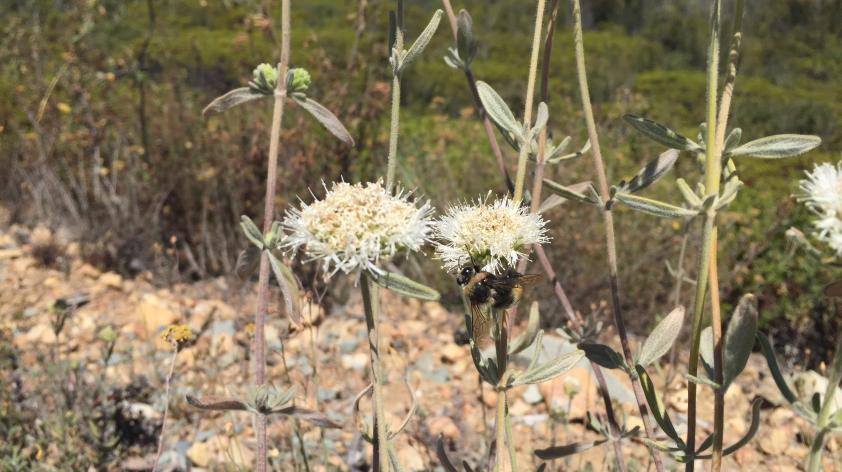
Saving San Diego’s Rare Mints
We made several seed collections from rare species in the mint family (Lamiaceae) this year. This important family is distributed worldwide, and contains more than 7,000 species in 236 genera. Characteristically, the members of this family produce volatile oils, resulting in amazing fragrances, and are often used by humans in cooking; basil, rosemary, sage, mint, thyme, oregano, lavender, and many more herbs are all members of the mint family. The family is also very important to our native plant communities and is a favorite food source for pollinators, especially native bees and butterflies. Salvia species are very common in coastal sage scrub and chaparral communities, most notably Salvia mellifera (black sage) and Salvia apiana (white sage), but there are many lesser-known members of the mint family that feed our native pollinators throughout their long summer blooming periods.
Lepechinia ganderi is known as Gander’s pitcher sage as well as San Diego pitcher sage. It is a perennial shrub that is known to have fewer than 20 occurrences (populations) in California. All of these occurrences are in southern San Diego County, but it also occurs in Baja California, where populations are not well studied. It is threatened by human development and increased wildfire frequency. The white tubular flowers are a favorite of bees, and I’ve also seen hummingbirds feeding on these shrubs. We made a seed collection on Otay Mountain this year
Monardella hypoleuca ssp. lanata is the felt-leaved monardella. It is a perennial rhizomatous herb, meaning it spreads by underground stems (rhizomes) and dies back at the end of each growing season. It occurs as far north as the Santa Ana Mountains in eastern Orange County south through San Diego County and into Baja. It is known from roughly 50 occurrences (populations) in California, and likely more in Baja Mexico. This is a favorite among butterflies, but its strong fragrance is popular with bees, wasps, and beetles as well. We made a seed collection on Otay Mountain this year.
Monardella viminea is a state and federally listed endangered species known as willowy monardella. This plant is a true San Diego County endemic. It occurs in rocky, sandy, canyon washes, west of San Diego’s mountains and is critically imperiled by urbanization, altered hydrology, and non-native invasive plants. It is believed that 8 or fewer natural occurrences exist. Furthermore, these 8 occurrences are not stable. Many consist of just a few plants, and invasive grasses, pollution, trampling and other threats that come with human development and urbanization continually threaten all of the occurrences. Like other members in this family, pollinators swarm to these fragrant pink flowers. We made 1 seed collection from this species this year. This important collection will conserve the genetic material from 47 individual plants and help to ensure that this beautiful plant won’t go extinct.
To read more about some of the plant species we’ve conserved this year as members of the California Plant Rescue project (CaPR), click the links below:
http://institute.sandiegozoo.org/science-blog/rare-plant-seed-collections-san-diego-county
http://institute.sandiegozoo.org/science-blog/conserving-rare-plants-otay-mountain
http://institute.sandiegozoo.org/science-blog/california-plant-rescue
http://zoonooz.sandiegozoo.org/2016/01/29/saving-san-diegos-rarest-plant-species/













